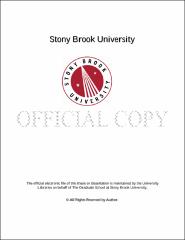| dc.identifier.uri | http://hdl.handle.net/11401/76439 | |
| dc.description.sponsorship | This work is sponsored by the Stony Brook University Graduate School in compliance with the requirements for completion of degree. | en_US |
| dc.format | Monograph | |
| dc.format.medium | Electronic Resource | en_US |
| dc.language.iso | en_US | |
| dc.publisher | The Graduate School, Stony Brook University: Stony Brook, NY. | |
| dc.type | Dissertation | |
| dcterms.abstract | Piezoelectric composites have played a major role in significantly enhancing the capabilities of hydrophones, sensors and actuators by providing better electromechanical coupling and lower acoustic impedances when compared to monolithic piezoelectric ceramics. Recent developments in the field of piezoelectric composites has led to the investigation into piezoelectric cellular designs that have the potential to further increase the sensitivity of existing piezoelectric devices. Accordingly the present study involves:- i) Investigating the role of topology and the direction of poling on the effective properties of piezoelectric cellular solids; ii) The role of deformation mechanisms on the structure-property relation of piezoelectric cellular architectures to categorize cellular topologies based on the dominant mode of deformation (i.e., bending vs. stretching) and iii) Develop an analytical model based on the homogenization technique to predict the overall electromechanical properties of piezoelectric foam structures. First, a finite element model is developed to characterize the complete electromechanical properties of the most general form of elastically anisotropic and piezoelectrically active foams with honeycomb structures has been proposed. Four classes of piezoelectric honeycomb structures are identified depending on the relative orientation of the poling direction with the porosity direction (longitudinal and transverse) and the geometry of the honeycombs (isotropic and anisotropic). To study the role of the major deformation modes in the ligaments of piezoelectric cellular struts on the effective electromechanical properties of the given cellular topology, three main architectures (foams) that exemplify bending and stretching dominated piezoelectrically active cellular solids cellular solids are considered. These structures represent hexagonal, tetragonal and triangular cellular topologies with the connectives of three, four and six cell walls per vertex, respectively. An analytical framework based on the homogenization method has been developed to predict the effective electromechanical properties of periodic, particulate and porous, piezoelectric composites with anisotropic constituents. Expressions are provided for the effective moduli tensors of n-phase composites based on the respective strain and electric field concentration tensors. By taking into account the shape and distribution of the inclusion and by invoking a simple numerical procedure, solutions for the electromechanical properties of a general anisotropic inclusion in an anisotropic matrix are obtained. Finally using Bloch's theorem in conjunction with finite element analysis, this work investigates the relationships between inherent microstructural features (such as lattice symmetry, relative density and constituent material) and the acoustic properties (such as wave dispersion, band gaps, and acoustic anisotropy) of architectured lattice materials. The coupling between microstructural features and band gaps is investigated in hexagonal lattice geometry which is inspired by the two dimensional Bravais family of lattices. | |
| dcterms.available | 2017-09-20T16:50:16Z | |
| dcterms.contributor | Kukta, Robert | en_US |
| dcterms.contributor | Alkhader, Maen | en_US |
| dcterms.contributor | Hwang, David | en_US |
| dcterms.contributor | T. A., Venkatesh. | en_US |
| dcterms.creator | Iyer, Sumantu | |
| dcterms.dateAccepted | 2017-09-20T16:50:16Z | |
| dcterms.dateSubmitted | 2017-09-20T16:50:16Z | |
| dcterms.description | Department of Mechanical Engineering. | en_US |
| dcterms.extent | 133 pg. | en_US |
| dcterms.format | Application/PDF | en_US |
| dcterms.format | Monograph | |
| dcterms.identifier | http://hdl.handle.net/11401/76439 | |
| dcterms.issued | 2015-08-01 | |
| dcterms.language | en_US | |
| dcterms.provenance | Made available in DSpace on 2017-09-20T16:50:16Z (GMT). No. of bitstreams: 1
Iyer_grad.sunysb_0771E_11955.pdf: 22928250 bytes, checksum: 20936269413d3d47516dc1bf3dba922e (MD5)
Previous issue date: 2014 | en |
| dcterms.publisher | The Graduate School, Stony Brook University: Stony Brook, NY. | |
| dcterms.subject | Analytical homogenization method, exotic materials, Cellular architectures. Piezoelectric foams, Dominant deformation modes, Finite-element analysis, Phononic band-gap materials(PBGs), Bloch Wave Analysis | |
| dcterms.subject | Mechanical engineering | |
| dcterms.title | Electromechanical Response of Piezoelectric Cellular Architectures: The effect of topological features and deformation modes | |
| dcterms.type | Dissertation | |

